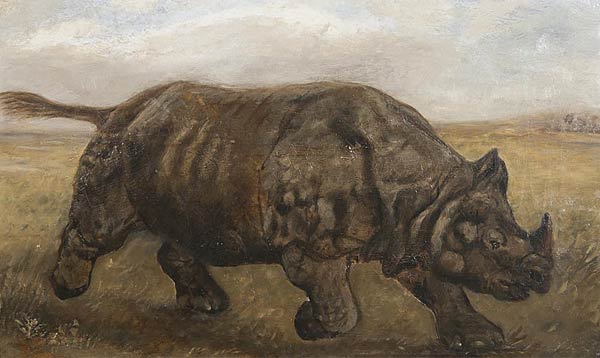Painting
Collection IndexRhinoceros
John Trivett Nettleship
1841 – 1831
- Circa 1915
John Trivett Nettleship was born in Kettering, Northamptonshire on 11th February
1841, the second son of Henry John Nettleship, a solicitor there.
Nettleship was for some time a chorister at New College, Oxford. Afterwards
he was sent to the cathedral school at Durham, where his brother Henry had
preceded him. Having won the English verse prize on ‘Venice’ in 1856, he was
taken away comparatively young, in order to enter his father's office. There
he remained for two or three years, finishing his articles in London.
Admitted a solicitor and in practice for a brief period, he decided to devote
himself to art, and entered himself as a student at Heatherley's and at the
Slade School in London, but was largely self-taught.
For twenty-seven years (1874 – 1901) he exhibited spacious oil pictures of
lions, tigers, etc., at the Royal Academy and for most of the period at the
Grosvenor Gallery. In 1880 Nettleship was invited to India by the Gaekwar
of Baroda, for whom he painted a cheetah hunt as well as an equestrian portrait.
In his later years he took to the medium of pastel, and, painting his old
subjects on a smaller scale, enjoyed greater popularity.
Nettleship was far more than a painter. His intellectual sympathies were unusually
wide. In 1868, when only twenty-seven, he published a volume of ‘Essays on
Robert Browning's Poetry,’ which was probably the first serious study of the
poet, and has passed through three editions with considerable enlargements,
of which the latest is entitled ‘Robert Browning: Essays and Thoughts’ (1895).
The book brought about an intimate friendship between the poet and his critic.
Another book that shows both his mature power of literary expression and his
opinions about his own art is 'George Morland and the Evolution from him of
some Later Painters' (1898). Here there are touches of self-portraiture.
He was one of 'The Brotherhood', a group of the 1870s including John Butler
Yeats and Edwin John Ellis. They were admirers of William Blake, on friendly
terms with the Pre-Raphaelites or at least the Rossetti brothers, and part
of the Bedford Park social and artistic group.
Nettleship died in London on 31 August 1902, and was buried at Kensal Green
Cemetery. A memorial tablet in bronze, designed by Sir George Frampton, with
the aid of two locally born artists, Sir Alfred East and Thomas Cooper Gotch,
was placed in the parish church at Kettering.

